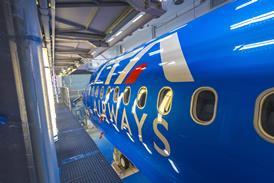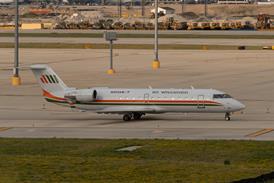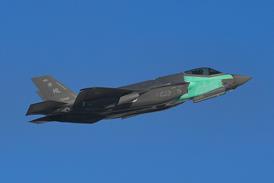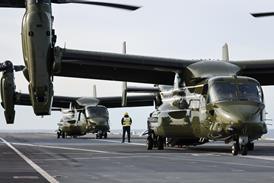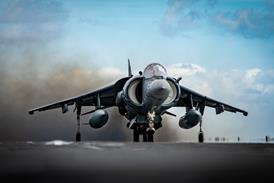David Hess became president of the United Technologies subsidiary on 1 January 2009. He is responsible for the company's global operations in the design, manufacture and service of aircraft engines, space propulsion systems and industrial gas turbines. With an installed engine base of 67,000, a global service network, and strong partnerships in building and servicing engines, the company reported revenues of $12.97 billion in 2008.
Hess joined Pratt & Whitney after four years as president of UTC division Hamilton Sundstrand, where he began his professional career in 1979. Under his leadership, Hamilton Sundstrand won major systems contracts on the Airbus A380, Boeing 787, Embraer regional jet family, Lockheed Martin F-35 Joint Strike Fighter, Mitsubishi MRJ regional jet and Sikorsky's CH-53K helicopter. Before becoming president, Hess headed the company's Aerospace Power Systems business segment, with responsibility for the air management systems, power systems and electrics.
What's good, the bad and unique about P&W's position in the aerospace industry today?
In general, we're dealing with a very tough economy like everyone else. That's the "bad". But if you look at the portfolio and products in all of our five businesses, we feel pretty good about our future and we're positioned for a strong recovery.
The "unique" is our continued progress on the Bombardier CSeries and Mitsubishi MRJ regional jet, GTF geared turbofan engines, combined with the growing orderbook for the Bombardier CSeries. We think we have a real game changer with the GTF technology offering for the CSeries and MRJ, but we're not done by any means.
 |
|---|
© Pratt & Whitney |
Our technology roadmap calls for a generation two GTF for the Airbus and Boeing future narrowbody engine competition expected to take place towards the end of the next decade. We think we can improve fuel burn by 1% a year or more beyond the 12-15% provided by the first-generation GTF, resulting in a GTF solution that has comparable fuel burn to open rotor designs, but without the noise, installation and certification challenges that we've seen from our studies of open rotors in the past. We've also made progress on the F-35 Joint Strike Fighter F135 engine programme, with the third turbine blade issues (earlier failure of blades in the low-pressure turbine third stage) in rear view mirror. The flight-test programme has been near perfect with respect to the engine: in over 100 flight tests, there have been no instances where aircraft were delayed or had to return to base due to an engine issue. We finished hover pit testing with a short take-off and vertical landing vehicle and the thrust of the propulsion system exceeded the requirement by more than 1%.
What was the strategy behind UTC moving you to P&W after four years as president of Hamilton Sundstrand, while Alain Bellemare, former president of P&W Canada, took on your former role at Hamilton Sundstrand?
I don't think it was any accident I ended up here while Alain went to Hamilton Sundstrand. United Technologies' president and chief executive Louis Chênevert's intention was to have a lot more collaboration and innovation between the two companies in terms of creating engine and system solutions for aircraft in the future. This gives us an exchange of best practices and talent across the division, including strategy meetings between Alain and myself.
We're looking at Hamilton Sundstrand composite fan blade technologies and starter-generators having applications to our engines. We continue to look at studies for the narrowbody replacement programme - if and when it gets launched, we'll have an integrated engine architecture to propose. That's the next big clean-sheet design for us.
QHow do you keep a healthy competition among separate yet common companies while working toward common UTC goals?
The trend has been toward collaboration rather than competition, although a little bit of healthy interdivisional competition is not a bad thing. Although the US and Canadian counterparts of P&W have traditionally worked independently, former P&W chief executive Stephen Finger had worked to have it as one company before retiring.
During that time we, as a team, developed the PurePower PW1000G common engine core for the CSeries and MRJ and potentially other applications. That core was also the basis of the engine for the Cessna Columbus business jet, which Cessna recently put on hold due to the economy. We know we'll have other homes for that core in other business jet applications. There's a huge advantage to P&W in terms of maximising our research and development investment to create other engines, and there's also a big push to do more and more standard common work from an engineering standpoint. A lot of practices are coming to P&W's large commercial engines business from Pratt & Whitney Canada. More and more we're taking advantage of best practices between the two.
What is the strategy going forward to balance civil and military work, manufacturing and aftermarket?
We have a good balance between our five businesses (P&W commercial engines, P&WC, military engines, Rocketdyne and P&W power systems). The balance works. We don't see that changing dramatically going forward, although we want to grow each one. In the large commercial engines business, we plan to further develop and apply the GTF, while increasing market share at P&WC for business jet engines, where the current market is presenting challenges but where we know growth will return. Engine work for the JSF is ramping up, though we'll have to navigate through Boeing C-17 and Lockheed F-22 issues in the near term (as the US military plans to halt production of both), there will be growth in unmanned systems, JSF and some others. We intend to try to not hold a percentage but grow all five.
How has the economy affected your plans?
There have been plenty of impacts and we're suffering the same impacts as other aerospace companies. On a positive note, we have seen spare part order rates and input to engine repair shops stabilise. At least that's some good news for now.
Source: Flight Daily News


